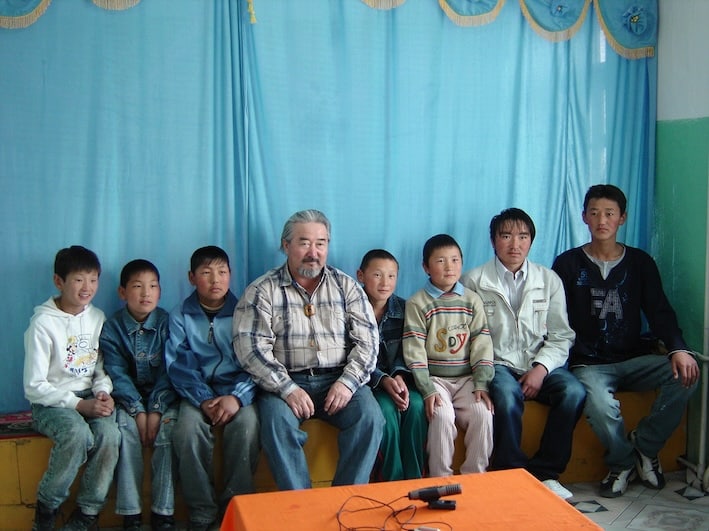The Institutionalization of Khöömii in Mongolia.
From the Steppe to the Stage, Johanni Curtet 2020
From the University to the Heritage of Humanity
Translated from the French by Michael Ormiston (apologies for any errors)
Khöömii1 (lit. “pharynx”), known in French as “diphonic singing”2, is a vocal technique in which a person produces several sounds simultaneously with their voice: a vocal drone, a melody of harmonics and resonances. It is categorized by two main emissions. The first, high (nariin), is produced by simultaneously pressing on the throat and pushing on the diaphragm, in order to create the effect of a valve on the body, allowing the mids and highs of the voice spectrum to be reinforced. Thus, many harmonics become audible; simply select them by modulating the tongue inside the oral cavity or by working on the opening and closing of the lips to make a melody heard. The second, low (budun), is made up of a double drone: one corresponding to the vibration of the vocal cords, the other coming from the ventricular bands, vibrating simultaneously an octave below. Depending on the individual, gender, chosen drone pitch, use of throat pressure, and choice of modulation technique, vocal timbre can vary considerably; there are more than twenty variations and as many ways of making them sound from one person to another3.
In Mongolian, khöömii is not categorized as singing (duu) but as a vocal technique. The person who practices khöömii, called khöömiich (khöömiichid in the plural), is not a singer (duuchin). Thus, to describe the act of khöömiilökh, the neologism “diphoner” Biphone?) seems more appropriate, as does that of “diphoner” (Biphoner?).
Khöömii is linked to the daily life and environment of nomads. Born from the imitation of natural sounds, it expresses a spiritual relationship with nature and shows respect for the universe. The make-up of khöömii can be explained by the layered, vertical and hierarchical spatial perception of the Mongols, which is found in this musical technique: drone, harmonic melody and resonances. An art of vocal timbre, khöömii is a representation of the world, a way of inhabiting it with one’s voice by playing in this space. In Mongolia, it is found in particular among the Khalkh – who mainly populate the country –, the Bayad, the Zakhchin and the Tuvans. The richness of this vocal technique is discovered in the diversity of approaches, from one musician and from one region to another4.
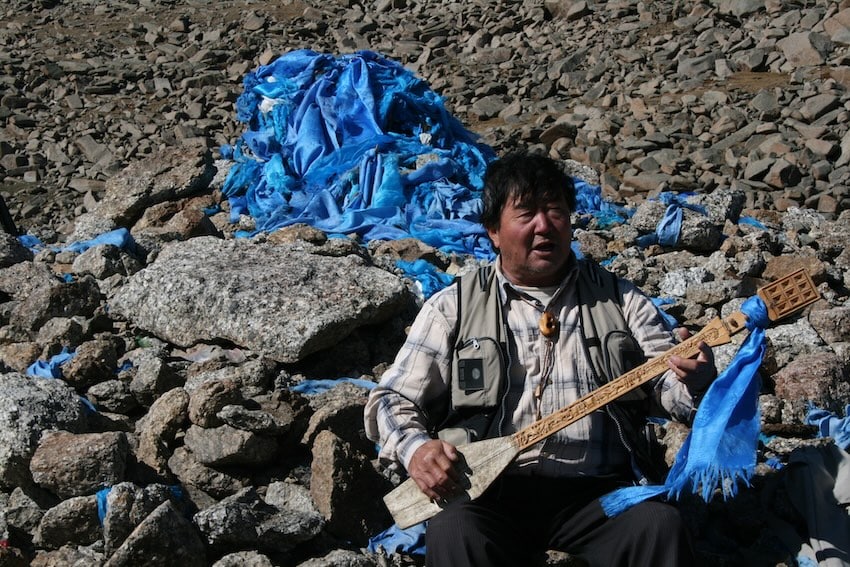
Figure 1: N. Sengedorj singing on the Altan davaa, to thank the master spirit/spirit owner of the place for letting us pass this Altai pass. Khovd province.
Source : Johanni Curtet ©19/09/2010
Before the 1950s, khöömii was practiced by only a few individuals in rural western Mongolia. Its practice was linked to the activities of nomadic life: herding livestock, dialogue with nature, vigil under the yurt/ger and domestic ceremony in honour of guests in particular. Its transmission from generation to generation was oral and operates in two ways: one is done at home (geriin surguuli), linked to the pastoral setting and the family or neighbouring circle. The other is based on teacher-to-student teaching. In both cases, knowledge is transmitted through different gestures. These gestures model the positions of the tongue and lips and their modulation possibilities. The teacher can use touch of the body, such as the stomach and throat, to indicate the correct ways to breathe and contract muscles. Listening is essential: the more the student is able to hear the subtleties of the tone of his/her voice, the more she/he will be able to highlight certain frequencies corresponding to desired aesthetics and techniques.
Finally, articulation exercises linked to the Mongolian language, lip and tongue strengthening, pressure to find the most accurate sound, or imitation of the sounds of nature (water, wind, etc.) make it possible to construct the voice of the future khöömiich/biphoner. All this according to the pace of learning consistent with each person’s capacity for understanding and assimilation.
Khöömii was not performed on the stage before 1954, when, during the Soviet period, a Mongolian composer “discovered” this vocal technique which he decided to present for the first time in concert. From then on, the progressive spectacularization of Mongolian overtone singing, until the 1980s, transformed the practice. The development of concerts and the distribution of recordings made it known throughout the world and Mongolian cultural policy took an interest in it. Notoriety influences the construction of heritage, which first results in the entry of khöömii into university education, then in the creation of a professional path crowned by obtaining a diploma.

Figure 2: R. Davaajav with students during a khöömii lesson under his yurt, Chandmani, Khovd province.
Source: Johanni Curtet ©summer 2009
These stages, from the stage to the classroom, made it possible to build khöömii into a national, then international musical emblem, after having included it on the Representative List of the Intangible Cultural Heritage of Humanity at UNESCO in 2010, under the title of “The traditional art of Mongolian Khöömei”5. Today, if the rural practice of khöömii persists, it is under the influence of the dominant academic model.
In this context, Soviet and post-Soviet policies, the entry into corrupt liberal capitalism, globalization and the adoption of UNESCO theories are all societal and historical changes associated with the development of spectacularization and academization. These processes have crystallized in the encompassing phenomenon of heritage. Mongolia uses the UNESCO lists as a label and proceeds to a selection of places, emblematic representatives of the practice, until the invention of an “official” history of khöömii. This institutionalization at all levels has social effects, such as the appearance of a divide between amateur and professional musicians. It also affects aesthetics and musical playing.
From an ethnomusicological and historical perspective, this article – which is based on field experience extending from 2004 to 2019 – returns to the spectacularization (Theatrical or Stage Performance), academisation and patrimonialization of khöömii. It questions the transmission and future of an oral tradition in the face of the challenges of its institutionalization.
The process of spectacularization (Theatrical or Stage Performance) of khöömii.
During the Soviet period, the spectacularization (Theatrical or Stage Performance) of musical traditions greatly contributed to the promotion of local specialties throughout Mongolia, while adapting them to the format of stage requirements. We will see how, from the steppe to the stage, khöömii arrived on the stage of theatres and what changes led to current practice.
Originally, khöömii was not practiced in a stage arena, in front of a concert audience, according to a Western understanding. In the 20th century, the spectacularization (Theatrical or Stage Performance) of rural music from Mongolia considerably modified habits by creating a new context for playing on a national scale. My field observations make it possible to show an evolution during the two important historical stages of contemporary Mongolia: the Soviet (1924-1992) and post-Soviet (from 1992 to present) periods.

Figure 3: Administrative map of Mongolia and places of practice of khöömii.Source :
The Soviet period (1924-1992): a stage of Mongolian musical acculturation.
With Soviet totalitarianism, aspects of nomadic culture had to be forgotten, or, at best, transformed in spite of themselves in order to survive. Talented artists who wish to continue practicing their art can exist if they adapt and reinvent themselves in directions consistent with the new regime (Marsh, 2009, p. 45). In the Party’s propaganda process6, music quickly becomes a tool of unification and identity. By retracing the stages of the Sovietization of music, the ethnomusicologist Carole Pegg shows that, from 1929, the political tendency was to keep only its democratic and socialist elements of culture.
The institutions and the Party controlled intellectual and artistic expressions through the creation of a bookstore, a newspaper, a radio and a state theatre in 1931. The 9th Party Congress made every effort to for musical activities and national songs be developed. At the beginning of the 1930s, Magsarjavyn Dugarjav (1893-1946) laid the foundations for the teaching of music and songs for this new era. It introduced courses and study cycles for actors, composers, singers and musicians (Pegg, 2001, p. 254; Legrain, 2011, pp. 136-153). Until the end of the regime, art and music were tools to socialize the population. To do this, talented musicians were first sent to schools in Ulaanbaatar and, the most talented, to schools in the Soviet Union. Mongolian music adopts Russian and Western musical terminology (Marsh, 2009, p. 53).
At the same time, in the capital, mixed ensembles of traditional and Western instruments were created, with the help of Russian musicologists, such as Boris Feodorovich Smirnov. Traditional Mongolian music, usually with anhemitonic pentatonic scales7, is orchestrated, harmonized and mixed with diatonic scales8. We are looking for crossovers with Western classical music. Tuning is based on A 440 Hz. As a result, the construction of traditional instruments and their playing modes are modified. From the moment theatres were built in each province, music was institutionalized and nationalized. The National Drama and Academic Theatre in Ulaanbaatar was founded in 1941 (Pegg, 2001, p. 254), its equivalent in Khovd in Altai in 1950. Annual music competitions are organized throughout the country. At the end of the 1950s, at the Secondary School of Music and Dance, taught both classical and traditional music. Musicians must reach the same level in both genres9 (Marsh, 2009, p. 55). Ceremonies become standardized and simplified, without religious or historical reference (Pegg, 2001, p. 255). The Party unifies the population under the identity of the dominant Khalkh ethnic group. Their language and culture are highlighted and must be accepted by all (Aubin, 1993, p. 159; Bulag, 1998, pp. 70-80). Despite this, for politicians, building a new national music (ündesnii khögjim) does not mean completely eliminating the old one; it was enough to change the meaning of the lyrics while maintaining its melodic form (Marsh, 2009, p. 46).
Compared to these modifications of instruments and sung repertoires, similar changes observed in khöömii are late for several reasons: on the one hand, in the first half of the 20th century, few individuals practiced khöömii in Mongolia – the technique is located in remote provinces and remains little known to the capital’s arts world -; on the other hand, it is music without text, therefore not carrying an ideological message or propaganda.
From the 1950s, khöömii developed with the arrival of the first diphones in theatres. With this spectacularization, vocal genres such as epic (tuuli) or khöömii are elevated to the rank of artistic practices (Pegg, 2001, p. 272). o
On the occasion of the Khovd10 decade festival, classical music composer Dagvyn Luvsansharav11 (1926-2014), in charge of the city’s theatre, incorporated khöömii into a mixed choir arrangement of a traditional Altai praise song (Enebish, 2009, p. 157; Sandagjav, 2010, pp. 40 and 120; Kherlen, 2010, p. 4). During a rehearsal, Seteviin Tsedee (1924-2004), a young Khalkh student and actor, comes to see Luvsansharav to show him what he could do with his throat. The composer, who discovered khöömii, decided to integrate this curiosity into his choir. The song ends with a majestic description of the Altai, translated by a sustained vocal chord, over which a line of khöömii is voiced. The passage, despite its brevity, will remain the highlight of the piece12. The idea of integrating this vocal technique did not come only from the composer, because this version of the praises of Altai was intended to be a tribute to Party politicians from the west, the choices and musical directions – from especially for a concert – had to be validated by the hierarchy.

Figure 4: Portrait of D. Sundui.
Source: Photo No. 4096, Center for Film, Photography and Audiovisual Documents of the Central National Archives of Mongolia. Year, funds and author unknown.
That same year, 1954, Tsedee was the first to sing in an a cappella choir on the stage of the Khovd theatre, first in rehearsal, then on that of Ulaanbaatar in performance. This was appreciated by the authorities present. The chorus of this song of praise (Altain magtaal) receives a certificate of honor from the central committee of the Party (Sandagjav, 2010, p. 40).
From the 1960s, the presence of diphone players in concerts became more regular. Originally from Chandmani, Khalkh Dovchingiin Sundui (1938-2003) succeeded Tsedee and Gaanjuurin Chimeddorj (1931-1980) at the Khovd theater. He embodied a model for generations to come. These individuals are presented by official history as the pioneers of a practice accepted as professional, because they became employees and sought perfect technical execution for the needs of the concert.
With them, from the 1970s, khöömii experienced a new boom. Sundui launched a “school” based on his personal style and paved the way for the next generation who will develop others. In the 1980s, these schools of oral tradition multiplied with the opening of the country, after the fall of the Soviet regime in 1990.
From the second half of the 20th century, the regularity of folklore festivals and music competitions created a new environment for traditional musicians. The competitiveness caused by the stakes of winning a medal reinforced competition13. The concert form is at its height in the national holidays programmed by the political class. It is an opportunity for amateur musicians who win competitions and for professionals employed by theatres to present their talents. At this time, there were two categories of artist:
1. The amateur (uran saikhanch), so called until the mid-1980s, then qualified as “popular talent” (ardyn aviyaastan);
2. Actors, musicians and dancers referred to as such, whose function is sometimes preceded by the adjective “professional” (mergejliin).
Furthermore, the calendar of official holidays played a role in the process of professionalisation of the performer. In the Soviet context, “leisure must be devoted to the improvement of the individual and the strengthening of his communist ideal” and each festival is a pretext for creation. Artists are subject to the same rhythm with the planning of cultural events throughout the year (Aubin, 1973, pp. 46 and 51), which contributes to their professionalisation, such as folk art competitions. All this contributes to the transformation of the mental universe of the breeder (Aubin, 1970, pp. 107 and 109). Competitions begin at the beginning of the year at the district level, continue in the spring at the provincial level and end at the beginning of July at the final meetings at the national level. For cooperatives, it is an opportunity to defend their honour by sending one of their own to represent the local colours even in the capital (Aubin, 1973, pp. 45, 52 and 53).
On the occasion of the first National Festival of Traditional Arts, Mongolian folklorist and musicologist Jamtsyn Badraa (1926-1993) developed the program and selection criteria, in which he included the category of “Mongolian folk musical arts related to the organs of the voice” (Mongolian ardyn khögjmiin ögüülekhüin erkhtentei shüteltsekh urlag). This festival contributed to the dissemination of knowledge of Mongolian vocal techniques, which influences the representation of the keepers of these traditions. Indeed, in the 1980s, Badraa knew all the places where khöömii was practiced in Mongolia, but selected and highlighted certain diphone players. He chose an area, Chandmani, and favored the majority ethnic group of Khalkh from the west and centre14.
He organization of the festival, based on the spirit of competition, also played a role in the development of khöömii. During my interviews, I noticed how much the interviewees focused on listing the list of distinctions won during competitions. These awards mark milestones in the career of the Mongolian musician, whether amateur or professional. They give him/her recognition within his/her community and allows him/her to enter other cultural centres, theatres and festivals. Obtaining recognition is also decisive for a young person from the countryside wishing to continue their studies in one of the musical institutions of the capital.
With this spirit of competition, khöömii was used for regional, national, then international identity purposes. The changes brought about by the stage setting, the relationship with a new audience and the meaning given to the performance, push the diphone players to think of new forms based on their vocal technique.
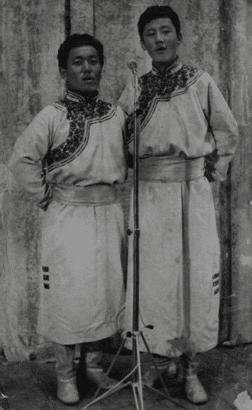
Figure 5: R. Davaajav and D. Tserendavaa (from left to right), during the Mongolian People’s Republic Arts Festival (Bükh ard tumnii urlagiin naadam)
competition, 1974.
Source: author unknown. Chandmani School Collection
Khöömii on the stage
So far, khöömii was only attached to one institution, the Khovd theatre. Once on stage, it experienced major developments which will crystallise into a reference model which is still authoritative.
Originally it was performed a cappella, without instrumental accompaniment. At the beginning of the 1960s, to enhance the presentation of this vocal technique on stage – and with the aim of creating national music – attempts at accompaniment emerged, first with a fiddle, a zither (yatga), then with a small orchestra composed of traditional instruments. The arrangements were written in the Western style, with harmonisation of traditional melodies.
In the first decades of Soviet rule, the representation and performance of music in theatres was subject to strict rules, under Party control, but starting in the 1960s, a class of intellectuals reawakened nostalgia for the past and the old way of life, showing that it could benefit the national interest. Continuing this movement, Natsagiin Jantsannorov (born 1949), Party member and supporter of modernity, composer and influential politician in the 1980s, highlighted popular culture. Working at the Ministry of Culture, he recruits Badraa as an associate. Both redirected political orientations towards a culture that was more Mongolian than Russian, by inviting Mongolian composers to assert their identity (Marsh, 2009, p. 101), which considerably influenced the presentation of traditional music on stage.
We are witnessing a new interest in virtuosity. Khöömii technique diversifies between rural and urban worlds. The herders who Khöömiilokh best in the countryside mostly have one-off concert activities and sometimes record an album or appear on a compilation.
Those who make it their profession abandon nomadism to settle in town, in Khovd, Ulaangom15 or Ulaanbaatar, to play in a theatre, teach in a school, or found an ensemble. In this context, the timbre of khöömii is shaped and transformed with the influence of the Western model of reference.
Diphoning with melodies from the Western classical repertoire amounts to comparing khöömii to lyrical singing and not to a vocal technique based on timbre and the concept of diphony. Remember that bel canto accompanied by traditional instruments developed successfully in the steppes (Aubin, 1973, pp. 51-52). Badraa gives the example:
In fact, having opera singers is one of the important achievements of our socialist musical culture. This is also our pride in development! (translated from Mongolian, Badraa, [1977] 2005, p. 151).
The notion of virtuosity found among bel canto singers is now essential in the practice of khöömii, particularly with vibrato. The ethnomusicologist Alain Desjacques explains that this vibrato comes with the playing of the horse fiddle (morin khuur) remodeled on that of the cello. With radio and television broadcasting, vibrato became a trend. This ornamental technique is becoming common among young professionals; Sundui, one of the first to manage to use vibrato with virtuosity, would have brought it to khöömii (Desjacques, 2009, p. 60). Trained in bel canto technique, Sundui brought a specific colour to his style, with a pronounced vibrato on the harmonics. The use of vibrato would also have an ideological dimension, supporting the idea that socialism is progress for society:
In order to literally create a contemporary classical art of communist Mongolia, the government sent a whole generation of post-war artists to train in the USSR and its satellite countries [and at the same time, Russian specialists stayed in the capital ]. […] The Mongolian leaders show a firm desire to create a new cultural identity, rooted in part in popular heritage, and the Russians spare no effort to help them do so (Desjacques, 2009, pp. 61-62).
Among the Mongols, the theatre/stage dimension renews the image of the diphones. He/she is no longer a khöömiich but takes on the role and attitude of a singer (duuchin), tending towards the opera model. The arrival of standards and devices, specifically adapted to this new environment, is reshaping the voicing of khöömii. To adapt to the stage, the duration of the pieces and the size of the repertoires are reduced. The temporality of life in the steppe is not that of the stage. Playing time is limited to match the standard concert format.
Khöömii in its spectacular (theatrical – Stage) form in the 21st century.
In the space of around forty years, with the aim of building national music and training artists in accordance with Soviet ideology, khöömii and rural musical genres were transformed for the stage. In the transition from the Soviet era to capitalism, a conception of traditional arts (yazguur urlag or ulamjlalt urlag) emerges, classified as “popular” (ardyn) for some and “classic” (songodog) for others, with Mongolian national music as a reference.
From 1990, Mongolia experienced a certain opening. The stage became a breeding ground for creation in all fields: contemporary or classical music, rock, pop, hip-hop, neo-traditional music, dance, theatre and performance. Khöömii was used in interaction with these genres and forms. Khöömiich developed their vocal technique to adapt it to these collaborations, while standing out from others in a search for originality. The diffusion of traditional Mongolian music on international stages – a dynamic initiated during the Soviet period under state control – became “out of control”. The increased diffusion of this music contributes to the development of khöömii as a world heritage. Indeed, acclaimed beyond national borders, it becomes an expression not to be missed in performances given abroad. International musical fashion then influences Mongolian professional musicians in two ways: on the one hand, with globalization, where experimentation in tradition is favorable; on the other hand, with meetings with musicians abroad and the musical experiences of Mongolian artists who reside there.
In Ulaanbaatar, for example, the National Drama and Academic Theatre, which houses the Ensemble of the National Academy of Music and Dance, presented musical and choreographic creations all year round, as well as a concert presenting traditional Mongolian diversity intended for tourists, played every day from May to September. This theatre is part of a process of creating and mixing music and dance, in the continuity of its primary functions under the socialist regime, which were to offer national music, based on existing traditions and the Soviet example. . In this era of globalization, it is a question of preserving and maintaining this national music now considered classical (songodog), by giving it an international dimension and by creating fusions16.
The academization of khöömii
Since the 1990 revolution, after having switched to a capitalist regime, Mongolia has been fully opening up to globalization. The population suddenly finds itself faced with freedoms of expression, religion and culture which are once again possible. The social changes that have occurred over less than a century, with the parallel development of cultural centres and theatres throughout the country, the creation of state ensembles and, from 1990, private theatres, have encouraged heritage artistic practices. Oral transmission still exists in the Altai countryside and certain masters, such as Dashdorjiin Tserendavaa (born in 1954), have opened the practice to women since the mid-1980s, then to foreigners after 1990. Khöömii developed rapidly in institutional education, placed at the centre of political programs. Academization formalizes the practice and made it a reference. Khöömii solidified and became systematized while its transmission in rural areas promoted diversity in the vocal timbres of students who did not seek to reproduce the voice of a master but to found their own way in the tradition, based on explanations and exercises experienced from their own practices. By measuring itself against nature, for example, singing outside into the wind, or next to a stream, the body is led to make the right gestures to hear itself better and help build the colour of the voice. It is also after constantly repeating the exercises for placing the vocal drone (looked for in a hurried voice), that the master will hear and appreciate the quality and level of refinement of the voice. It is therefore by ear that the stages of learning are validated, based on the construction of the timbre of the student’s voice. When he/she succeeds in diphonating a melody in a given technique, he no longer needs the referent because this confirms that he has the keys to understanding how to practice the repertoire alone. Rentsengiin Davaajav (born in 1952) testifies that “in general, if a person has learned everything about khöömii, he will be able to overtone any song”17.
The institutionalized transmission of khöömii.
If Badraa played an important role in the study of traditional Mongolian music, he also largely contributed to their institutionalization. As a continuation of this process initiated in the Soviet period (Marsh, 2009, pp. 47-72), he established a series of khöömii courses in Ulaanbaatar, with Khalkh teachers, such as D. Tserendavaa, Taravjavyn Ganbold (1957-2011) and Baataryn Odsüren (born 1949). In 1992, again on the initiative of Badraa, a first class of khöömii was created at the National University of Mongolia (Kherlen, 2010, p. 4). The objective is to learn theory. In 2006, a second class issuing a professional Khöömii diploma opened at the University of Arts and Culture in Ulaanbaatar (Kherlen, 2010, p. 4). In each university, teaching is entrusted to Odsüren. Also a Khalkh, he learned Khöömii through contact with those around him, in the pastoral setting of his native province of Zavkhan.
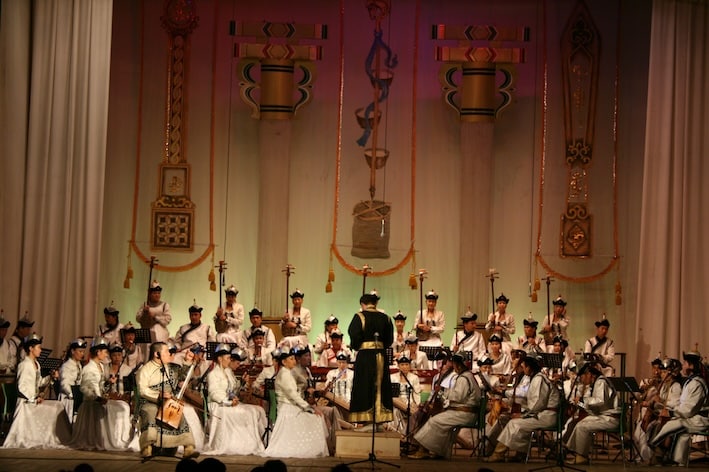
Figure 6: Soloist Oyuungereliin Chuluunbaatar and the orchestra of the National Academy of Music and Dance Ensemble, Ulaanbaatar.
Source: Johanni Curtet, ©26/06/2010
Until October 2019, the date of his retirement, he was the only teacher to teach as a civil servant. This position has allowed him to shine in border countries and internationally. He still teaches in Inner Mongolia (China) as well as in Buryatia (Russian Federation), in regions populated by Mongols.
Odsüren was the first professor to transmit in a university setting. Unlike the Khöömiich from the Altai provinces, he developed a pedagogy strongly inspired by the Western conservatory.

Figure 7: Building No. 2 of the University of Arts and Culture,
where B. Odsüren’s khöömii courses are taught, Ulaanbaatar.
Source: Still from the rushes of the film Maîtres de chant diphonique,
J.-F. Castell, ©summer 2009
The development of a pedagogy.
Each of the four levels taught at the University of Art and Culture corresponded to objectives to be achieved. The transmission focused on a practice intended mainly to train stage musicians. This fact considerably influenced the requirements of academic teaching which is based on technicality and virtuosity, rather than on intuition and spontaneity in the education of singing in rural areas (Legrain, 2010, p. 62; 2011, pp. 313-416). However, despite university requirements, teaching took place mainly orally, without a textbook, using the rural mode of transmission, based on gestures, observation, listening and imitation.
This course was attended by young students from all over the country. Oddly enough, those who have already started learning Khöömii in the countryside, in the Altai provinces, were the fewest. Young people from Inner Mongolia and other foreigners came for a few months or to follow the entire training18.
The selection of future students works almost like at the conservatoire. Odsüren began by teaching thirty mandatory hours before seeing whether or not the student could learn. During this trial period, the student worked on his/her vocal drone in the interval of a fifth. Once the thirty hours had passed, if the teacher was not satisfied and the student seemed to want to continue, he gave him one more chance. The student could freely decide whether or not to stop. For the first two classes, graduating in 2009 and 2013, the students knew the khöömii technique beforehand, having already started their learning with their family or with an external master. This was no longer necessarily the case with the following courses. In the city, the relationship to training time changed and some young people preferred to enrol directly at the university, within a clearly defined framework.
The teaching provided by Odsüren was the same regardless of the gender of the student. He did not adapt it for women either, considering them capable of the same results as men. During this four-year training, weekly courses were spread over four levels, culminating in end-of-year exams. In the first year, in the first semester, students worked on breathing and contraction of the throat muscles. In the second semester, it was the modulation of vowels and the integration of around ten simple melodies from the repertoire. The course intensified in the second year with work on more complex melodies. It was therefore through learning the repertoire that the teacher helped the students progress on the contraction of the throat, the breathing technique, just as fundamental as in a rural environment, and the placement of the tongue in the different harmonic modulation techniques. In the third year, the semitone in harmonic modulation was covered. Students must be able to diphonate both in the scales of traditional Mongolian music, pentatonic and without semitones, but also on European scales including semitones. The tongue placements to achieve the latter are difficult and require technical prowess. In the fourth year, students learned to diphone the most complex melodies of the repertoire, foreign melodies, such as those of Italian opera and melodies with fast rhythms, more difficult to achieve with tongue modulation. If the technical aspect seems to hold a large place in learning, once the modulation of harmonics has been mastered, the teaching focused on the aesthetics of the melody, working on vibrato and ornamentation techniques. Ultimately, the professional khöömiich must know how to khöömiilokh on three octaves while reading a score. For Odsüren, knowing how to read music and knowing its theory are the marks of assured professionalism.

Figure 8: B. Odsüren at the piano, during a lesson with first-year students, University of Arts and Culture, Ulaanbaatar.
At the same time as students progressed, they must regularly participate in concerts because performing on stage goes hand in hand with academic learning. This was an opportunity for Odsüren to train them in the attitudes to adopt on stage, because this space will be their main workplace once they graduate.
To maintain a link with rural practice, Odsüren regularly took his students into nature around Ulaanbaatar. It alternates between a getaway to the Bogd mountains to the south of the city, or to the north, between the hills which border the last yurt/ger districts.
Each level culminated by an end-of-year exam in which students took a series of practice tests, in order to validate their acquired knowledge. At the end of this training, a diploma grants the status of professional Khöömiich recognized by the State and by all cultural institutions in the country.
During the first three years, students take an exam which consists of diphoning three or four melodies from the repertoire, increasingly difficult to perform, accompanied by a lute, a fiddle, a small ensemble traditional instruments or playback.
Other courses, compulsory and complementary to the training, are validated gradually according to the modules followed: music theory, Western music theory, piano reading, English or Russian, history, Eastern music, philosophy, singing theory , choir, diction, horse fiddle and acting.
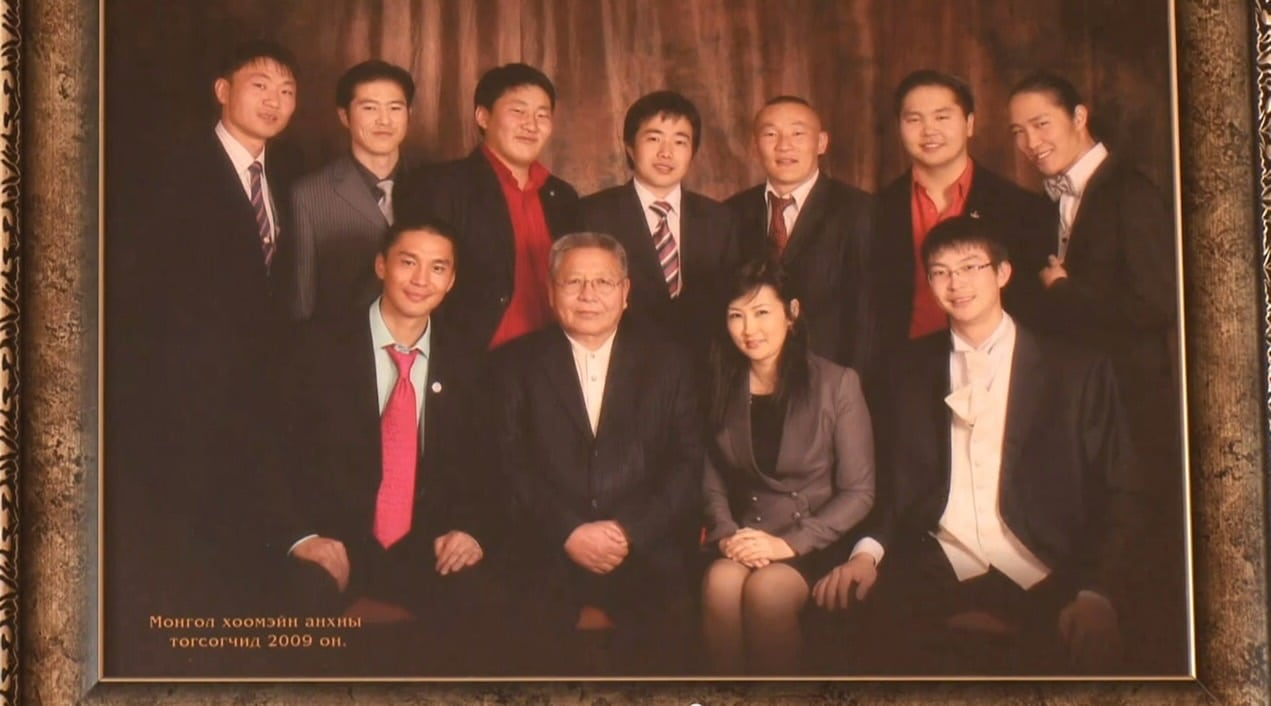
Figure 9: The first class of khöömiich from
the University of Arts and Culture, graduated in 2009.
The photograph is displayed large on a wall of Odsüren’s classroom.
Source: still from the film Maîtres de chant diphonique, J.F. Castell, ©summer 2009. Castell, J.-F. (2010). Masters of overtone singing. Movie 53′.
Les Films du Rocher, La Curieuse.
For the final khöömii exam in fourth year, students must sing five melodies from different repertoires. Apart from traditional music, there is vocalization and an air of opera or foreign classical music. Finally, the class organizes a big concert in one of the city’s theatres. The examination ends symbolically in front of the public, in a situation which will be similar to that of their future work.
In 2019, opportunities were still relatively limited for young qualified khöömiich. Depending on their relationships, some could join a national or private ensemble and become a civil servant in Ulaanbaatar, others local ensembles in the provinces or within the cultural centre of their native region. As teaching positions in institutions remain rare, the transmission of khöömii in the private context developed mainly in the city, either through private lessons or through small music schools, sometimes founded by graduates themselves.
Since the end of the 1970s, when the opportunity to join a theatre or an ensemble presented itself, many diphone/biphone players who had learned in the countryside took the opportunity to make a living from their music and settled in the city.
These artists, most of whom came from a nomadic life, recognized nationally and sometimes internationally, are among the local references in their respective regions in terms of transmission. Caught between rural roots and the urban academicism of Ulaanbaatar, these masters seeked to distinguish themselves from others, in a play of interactions between the steppe and the city which questions the identity of the Khöömii tradition.
Being a “professional khöömiich” in Ulaanbaatar means knowing how to read a score while diphoning, knowing music theory and being in a creative process, young people thus stand out from the generation that precedes them. However, some khöömiich from rural areas consider themselves “professionals” because they earn their living with khöömii, although they are criticized for not having a diploma. Lacking official status, they are considered “amateurs” by institutions.
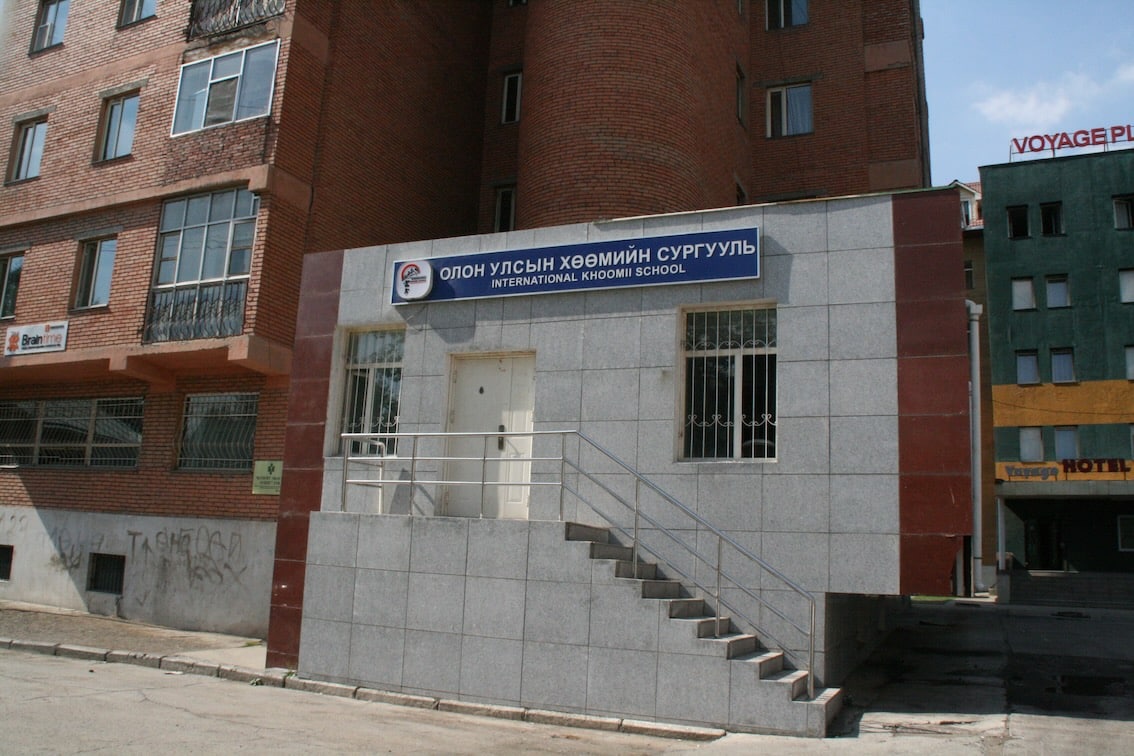
Figure 10: the international khöömii school (private), created by J. Mendbayar, one of the students of the first class of professional talkers, Ulaanbaatar. Source: Johanni Curtet ©summer 2017
Communities that wish to recruit them get around this difficulty in their relations with the ministry, by presenting them as actors or dancers. From now on, musicians established a distinction between “traditional” transmission (ulamjlalt) in rural areas and “professional” learning (mergejliin) provided in the city.
By tracing the links from master to student, I noticed that these “popular talents” were once the models of professionals in practice today. The teaching of Mongolian music of oral tradition in institutions and the fixation of repertoires through writing have increased the gap between generations. For khöömii, this differentiation reached its peak with the opening of its teaching at university. The Khöömiichid herders say that, not knowing how to read music theory, they do not consider themselves good khöömiich in the eyes of the younger generation, oriented towards technicality and virtuosity.
